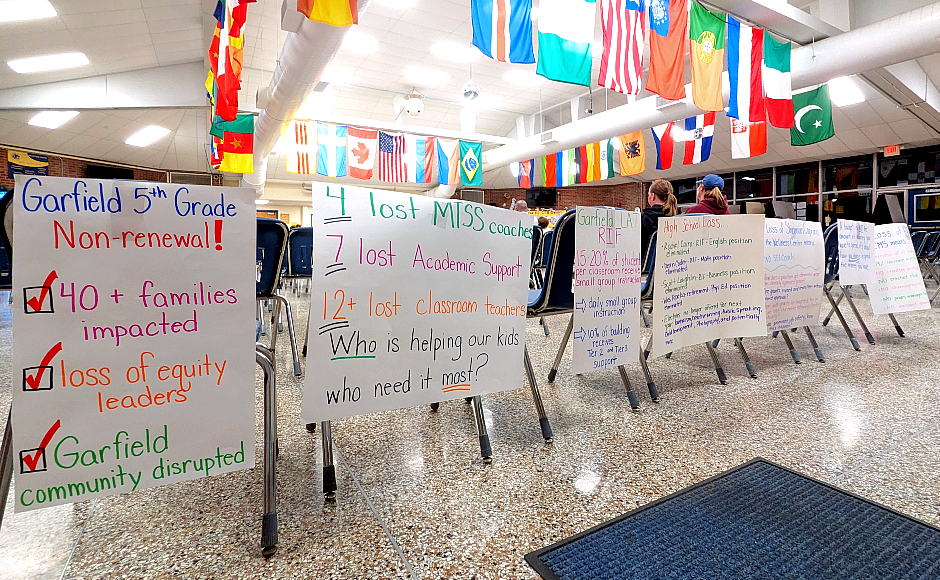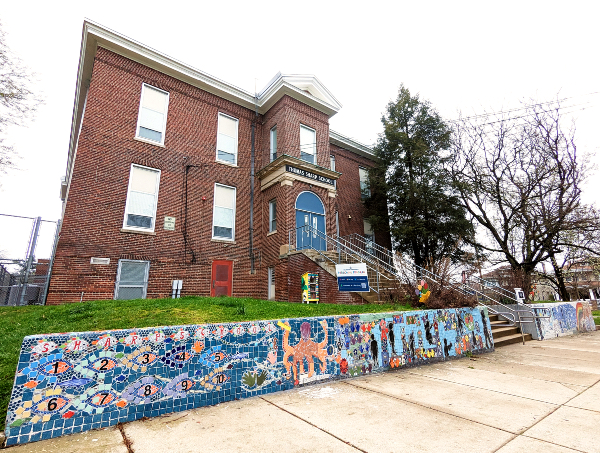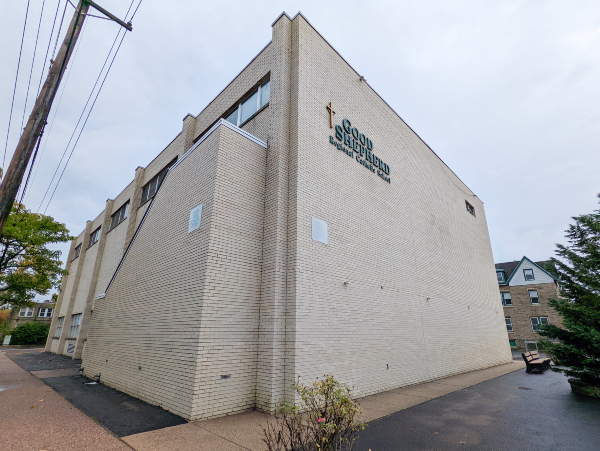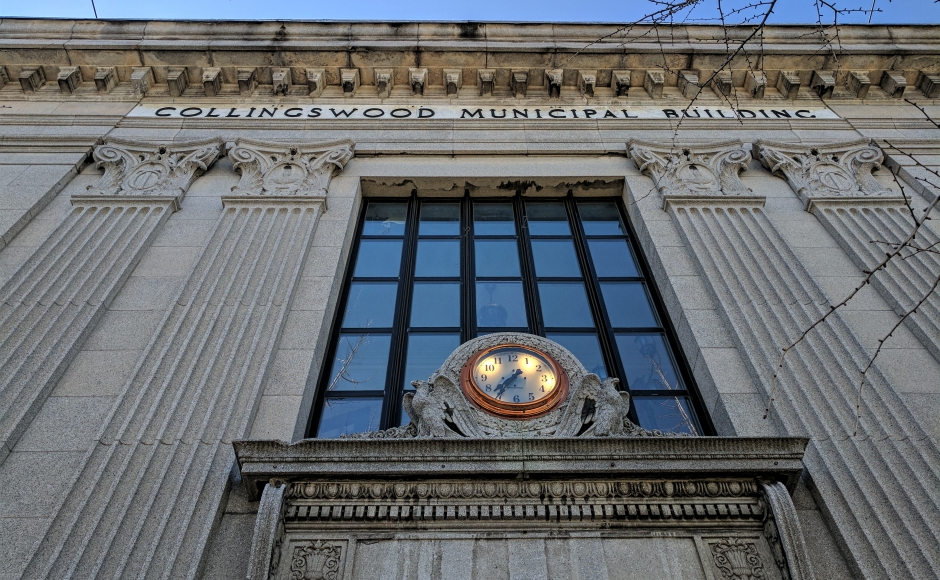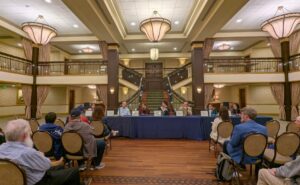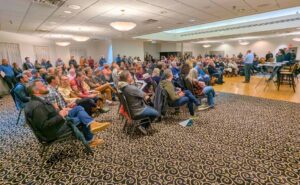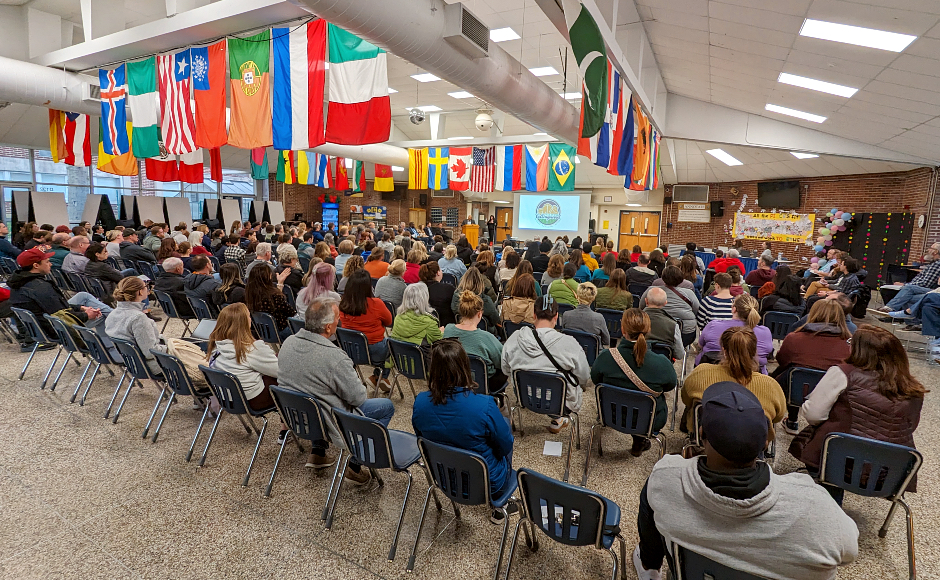
In March 2024, Collingswood Schools introduced a $45-million bond referendum to a packed house. Credit: Matt Skoufalos.
Since the public introduction of its $44.5-million bond referendum in late March — in which the Collingswood Board of Education (BOE) proposes to acquire the Good Shepherd Regional School for the purpose of transforming it into an upper elementary school — the plan has faced questions from the voting public.
Good Shepherd would become the largest and newest elementary-grade building in the district, but to comply with New Jersey Administrative Code for educational facilities (NJAC 6A:26), Collingswood must show a deficit of seats in order to acquire it.
That means closing some schools.
Based on the age of the buildings and the cost of renovating them into compliance with the Americans with Disabilities Act (ADA), the BOE has proposed shuttering the Thomas Sharp and James A. Garfield Elementary Schools, an option that some residents find unacceptable.
Two weeks before the BOE formally resolved to put the referendum on the ballot at a July 17 special meeting, Collingswood Mayor Jim Maley sent a counter-offer to district leadership.
In a July 2 letter to the BOE and to Collingswood Superintendent of Schools Fredrick McDowell, Maley offered for the borough to “acquire Good Shepherd now and hold it for future School District use.”
The mayor met with members of the BOE ad hoc facilities committee and McDowell in person on July 11 to discuss the details of the referendum, during which meeting BOE President Regain Kaiden hand-delivered a written counter-proposal to his offer.
By accounts from both sides, that meeting soured quickly. Maley regarded Kaiden’s counter-offer — that the borough could instead purchase Garfield at market price and oversee its redevelopment, cover the cost of courtesy shuttles for students, and collaborate on a re-use of Sharp — as asking the borough to “write a check for all the things they have not gotten a plan together for.”
The two sides wrapped the meeting up much in the same camps they’d entered it.
After the meeting, Maley said that he followed up with BOE members Kelly Maia and Meghan Mikulski, who are not on the ad hoc committee, and were not present at the July 11 discussion, to ask whether the entirety of the board had seen his offer.
“I saw them, and I said to them, ‘Did you get the letter?” the mayor said. “On July 15, 16, they did not know anything about it, which is just stunning.
“They didn’t know we sent the letter,” Maley said. “They didn’t know we had met on the 11th; they didn’t know that the Board had answered on the 11th. I gave them the letters, and in my e-mails to the superintendent, I asked that he please distribute this to all members of the board.”
The mayor’s July 2 e-mail to Kaiden with the offer to purchase Good Shepherd School attached contains the same request to “Please distribute it to all members.” Maia and Mikulski did not respond to requests to confirm his account.
McDowell and Kaiden have since said that they believed both the July 2 and July 11 letters describe a deliberative dialogue between the borough and the school district, and considered them privileged communication. Maley disagrees with that assessment, saying that he didn’t believe there was anything further to discuss after the July 11 meeting.
Both letters first surfaced online in an anonymous social media post July 22, less than a week after the July 17 special meeting formally resolving to put the bond referendum on the ballot.
A July 31 Open Public Records Act (OPRA) request revealed that only one person filed a request to view those letters between the July 11 meeting and the time they first appeared on social media.
That was Collingswood Education Association President and Negotiations Chair Robin Hogan, whose OPRA request was filed with the borough July 15.
Hogan said she filed the request because she was curious to learn whether the borough and district had communicated with one another about the referendum. She denied having passed the letters off to anyone else afterwards.
“Imagine my surprise when I got those documents,” Hogan said. “But I didn’t do anything with them. I’d heard there was communication; I’m hearing all kinds of rumors. Then I sat on it once I read it because I said, ‘This is between them. They’re going to have to sit on it because this is a big thing.’”
Hogan, who said she does not have access to social media, said she “was shocked too because I got a screenshot” that they had been shared online.
“It didn’t come from me,” Hogan said.
“I don’t have a whole lot of conversations about the referendum with central admin.”
Asked for her take on the material, Hogan said she found it “very interesting,” but added that the notion of the municipal government holding a building for purchase by the school district “is between them and the taxpayers.”
She had a similar take on the mayor’s suggestion that the district seek public borrowing for an operational referendum rather than an infrastructure bond, especially as the district and teachers union are currently headed to mediation to shape the terms of a new contract.
“We should be having those conversations with the board, and it should not be done publicly,” Hogan said. “We need to settle this in a way that’s building up the schools and building up the town, and not tearing it apart by talking to other people about it.
“The kids are watching,” she said, “so that is another reason why I want to be really mindful. I love Collingswood; I raised my kids there, and I want to see it grow and develop. I don’t want to participate in the things that are tearing it apart. It should all be about the kids.”
A question of process
Maley’s chief critique of the referendum has been about how the project was shaped.
He said that the Board ought to have conducted more public outreach and engagement before presenting a plan that involves elementary school closures. The mayor further has maintained that some BOE members didn’t learn the specifics of the referendum until two weeks before it was rolled out to the public.
“It was put together for months before, and the entire board was not part of the process,” Maley said. “There was no allowance for discussion. What was presented to them was exactly the same thing that was on the ballot that’s being rolled out to the public.
“All of this goes back to our main premise, which is, it’s the process,” Maley said. “I get that they say, ‘We had no choice.’ If that’s the end result, a better process helps everybody process through to that. That is what we think is splitting everything up.
“Nobody disagrees with the goals,” he said. “What they think is going to solve education achievement is alignment of grades. That’s the goal. The issue is how do you get there?”
The mayor similarly has been critical of the way the Board has managed its books, going as far as to suggest that the district should instead be seeking a referendum to cover its ongoing revenue shortfall — the product of a widening gap between the local cost of services and fair-share levies and adequacy funding determined by the state of New Jersey — because public sentiment might be warmer to that question.
His July 2 letter suggests that tabling the facilities question would allow the district “to focus on the resolution of current operational issues… [and] evaluate the possibility of placing a budget referendum on the ballot to increase the size of the budget to address teacher retention, salary guide, class times, and other current operational issues,” which the BOE has said are on the table in contract negotiations with the teachers union.
“The reason we brought that up is to say, ‘this is an opportunity to seriously look at doing a budget referendum,'” Maley said.
“It is going to be out of the norm, it is going to be a bunch more, but let’s engage people.
“The temperature I have is that that’s a lot more likely to pass, and then you can still be working on what’s the plan for grade alignment.”
Collingswood Schools Assistant Superintendent and Business Administrator Beth Ann Coleman has said that an operational referendum seeking to recover the $3.69 million Collingswood was shorted in its adequacy calculations would add about $800 annually, permanently, to the average local household tax bill.
The district raises about $18.7 million of its school revenues from local levies, but according to the School Funding Reform Act (SFRA), its local fair share is $24.35 million. Were the BOE to seek a referendum to cover that $5.65 million difference, taxes would go up about $1,191 for a home assessed at the borough average value (about $235,000).
Coleman has also opined that either option could result in a shortfall of future state aid if the Department of Education determines that such a referendum was undertaken to circumvent the 2-percent property tax cap. Comparatively, the $45-million bond referendum is estimated to bring household taxes up about $500 per household, on average, on a 30-year timeline. (View the district tax impact calculator here.)
Regardless of the cost of improving its infrastructure, or the value of aligning borough elementary schools by grade level, Maley said that removing Sharp School from its neighborhood plays into social narratives that the west end of Collingswood is somehow shorted the same consideration or interest the rest of the town receives from its institutions.
“For all my time doing this, the west side always says, ‘We’re the orphans; we don’t get anything,’” Maley said. “The separation by the [White Horse] Pike makes it feel like it’s different.”
Whether he buys into that notion or not, the mayor said that perception must be taken into consideration in governance.
“It doesn’t matter if I think it’s real or not, it’s something that’s a perception of the community,” he said. “If you’re going to take that school out of the community, they need to be involved in that decision. They don’t get told about the decision, and then they can vote it up or down. That’s our objection.”
The mayor maintains that “there’s all kinds of things we could do to save Sharp School,” albeit without offering any specific plans as to how that could be accomplished. He contended that, were both governing bodies to have collaborated on the process, a different outcome might have been achievable, even if only in communicating the inevitability of the need for change.
“I haven’t looked at any documents about it; I haven’t been involved,” Maley said. “We’re not saying the goals are wrong. We’re saying there is not only one path to that. More of a public engagement process gives everybody a chance. If we were involved, there would be a much different result.”
Committee structure
For their part, however, school district leaders say the spirit of collaboration has been missing from interactions with the borough municipal government, both in terms of the current referendum issue and in criticisms of how it was shaped.
“We don’t critique other governmental entities for the processes they use because they have different rules to abide by,” McDowell said.
“As a school district, we are governed by New Jersey state statute very different than New Jersey municipalities.
“When working with children, the rules and expectations from the Department of Education are very clear,” the superintendent said. “We as a district pride ourselves on following the rules in all the state statutes.
“What we were putting forward was what could be approved through the state of New Jersey to come for a public vote,” he said. “When we went to the community, we said, ‘This is our due diligence; this is our process.’”
The superintendent pointed to community conversations dating back to a September 2022 public meeting as the earliest public presentation on the facilities needs of the district. That presentation, dubbed Vision 2026, describes a six-month engagement process involving 1,100 local stakeholders.
Although it doesn’t discuss closing school buildings, the presentation specifically identifies Good Shepherd as the target of a “multi-year lease with a purchase option,” and outlines enrollment projections that exceed the capacity of the district to meet them.
“We were very clear with our community since September 12, 2022 that we were going to take all the time we needed with our architects, and when we had additional information, we would present that,” McDowell said.
The superintendent also challenged the mayor’s assessment both of how the plan for district facilities was drafted, and how the board was notified throughout that process. McDowell described the ad hoc committee process as a “structure that’s been in place in this district for two decades,” done in groups of fewer than five members to avoid congregating a quorum that would necessitate a public meeting.
The 2021 New Jersey School Board Association Guide to Board of Education Meetings in New Jersey notes that the ad hoc committee practice is commonplace statewide:
“Boards may use a committee structure, where select members — totaling less than a quorum of the board, often working with the superintendent or key administrators, study a specific issue and make recommendations to the full board for a vote. By the time the full board meets for a regular “agenda” or “business” session, where it votes on issues, agenda items usually have been vetted or studied.”
Throughout that process, McDowell said, the full Collingswood Board of Education was kept abreast of the facilities discussion, both in retreats and direct communication from district professionals. Although the Board wasn’t in position to present the plan in full to the community before its March 2024 retreat, he said that BOE members were updated throughout its development.
“Along the way, whenever we’ve made progress, the full board has been kept aware,” the superintendent said. “I send out messages to the full board with frequency. They’re just not allowed to comment online because that constitutes a meeting, and a meeting must be public.”
In addition to sharing the findings of its architects and engineers with BOE members, McDowell said the results of those facilities studies, in combination with property acquisition laws for school districts, don’t allow the district to pursue the acquisition of Good Shepherd without closing any existing facilities.
“The law is extremely clear: we are unable to access state funding and go to ballot question when we have not demonstrated there are unhoused students,” he said. “Since 2022, the understanding between the district and the borough is that we were seeking to acquire this particular building. In order to acquire this building, we must un-house students.
“That means we have to decommission current educational space, and show enough of a need to warrant expanded educational space to do it,” McDowell said. “The two buildings selected [Sharp and Garfield] are the oldest. Our engineers and architects with a combined 50 years of experience analyzed multiple variables. They made recommendations.
“We can keep with the woulda, coulda, shoulda,” the superintendent said. “We’re trying within the boundaries of the law and our borrowing capacity to put the best foot forward at this time.”
Moreover, McDowell said, knowledge of the plans being developed by the Board doesn’t obligate its members to endorse those plans, especially if they disagree with them.
“The board is not a rubber stamp, and all the members of the board don’t think alike, don’t have the same opinions, and are entitled to vote with their conscience,” the superintendent said. “The distribution of information has been there over and over and over again.”
Limited options
Kaiden said she was disappointed by the entire exchange with the municipal government, much less the public nature of it.
“If we’re all working towards the same goal, can we do that?” Kaiden said.
“To go back and forth about who said what when, I don’t know what good that does anybody. To cast doubt on process is disappointing as well.
“The mayor has never waded this far into the running of the school district before, and that’s not his role, and I’m not sure why he’s doing it now, publicly, not privately,” she said. “The letter that he sent is not an attempt to work together.”
No party in the conversation — not the mayor, the board president, nor the superintendent — says they’ve been able to work together on district facilities and infrastructure issues.
“We thought we were collaborating at least with the fields,” Maley said. “A month before this plan went public, we were at a meeting together. We had no idea this was going on.”
“I have not seen, in my almost nine years on the board, borough leadership actually being interested in real partnership with the school district, ever,” Kaiden said.
“We are open to partnership, but we have not yet had a long-term, sustainable, demonstrated partnership for almost three decades,” McDowell said. “We welcome partnership, but partnership has to be mutually beneficial, and we have to all be on the same page.”
Kaiden said the reason the BOE introduced the details of the referendum publicly in March, six months ahead of a September vote, was to engender public discussion on the issue to allow the community to weigh their options ahead of casting their vote. She maintains that the board has facilitated public conversations on the issue in the spirit of continued engagement.
“It’s for us to put out a plan that meets the needs of our community, following the structures that we are bound by, and then it is the community’s decision whether they think that’s the right way to go or not,” Kaiden said.
The board president further objected to the mayor’s notion that there’s a broader range of choices on the facilities issue than are being presented to the community, or that the borough purchasing Good Shepherd would make renovations to Sharp and Garfield financially or procedurally feasible.
“It’s disingenuous to reimagine Sharp as a functioning school because we couldn’t afford to do that,” Kaiden said. “We don’t have the borrowing power to knock down two schools and build two new ones.
“We can’t just go out there and say, ‘whatever you want,’ because unfortunately that’s not the way that it works,” she said. “There’s too many restrictions in place. We would have wasted their time by asking in the first place.”
Where the district could benefit from partnership with the borough government, both Kaiden and McDowell agree, is in helping redevelop Sharp and Garfield into community assets.
“I think there is great opportunity to reimagine what that Sharp School place can be, and we invite the borough to participate in that reimagining with us and the community,” Kaiden said.
“We’ve made strategic investments in Collingswood for the last three decades that have greatly benefited the quality of life for Collingswood residents, myself included,” McDowell said. “We have not made requisite investments in our schools to the same degree in Collingswood, and now the populace is demanding that we do so.
“It is our responsibility to put the best proposal forward that addresses many of the issues that have been articulated to our school members, board members, community members, for at least the last decade,” he said.


